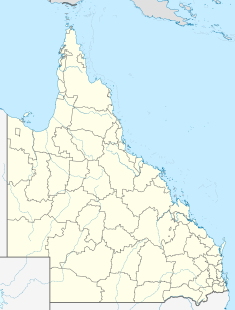Chapel of St Peter's Lutheran College
| St Peter's Lutheran College Chapel, Indooroopilly | |
|---|---|

Front of the building, 2014
|
|
| Location | 66 Harts Road, Indooroopilly, City of Brisbane, Queensland, Australia |
| Coordinates | 27°30′18″S 152°59′06″E / 27.5049°S 152.985°ECoordinates: 27°30′18″S 152°59′06″E / 27.5049°S 152.985°E |
| Design period | 1940s - 1960s (post-World War II) |
| Built | 1968 |
| Architect | Karl Langer |
| Architectural style(s) | Modernism |
| Official name: Chapel of St Peter's Lutheran College, Indooroopilly | |
| Type | state heritage (built) |
| Designated | 7 December 2012 |
| Reference no. | 602816 |
| Significant period | 1968 |
| Significant components | chapel, spire, pathway/walkway, courtyard, bell - church, memorial - war |
| Builders | W. W. Groom |
St Peter's Lutheran College Chapel is a heritage-listed chapel at 66 Harts Road, Indooroopilly, City of Brisbane, Queensland, Australia. It was designed by Karl Langer and built in 1968 by W. W. Groom. It was added to the Queensland Heritage Register on 7 December 2012.
The Chapel of St Peter's Lutheran College built in 1968, was designed by architect, Dr Karl Langer as the centrepiece of the school grounds, complete with a tree-lined plaza, forecourt, bell tower, and reflecting pool. The chapel is used regularly by the school and the local Lutheran parish for liturgical and general assembly purposes and remains central to the school community.
The area now known as Indooroopilly was surveyed in 1858 and first settled in 1860. The area was subdivided into farms and later into residential allotments. Prior to 1870 there were few houses built in the area but settlement of the district received impetus from the opening of the Brisbane to Ipswich railway in 1875. During the 1880s and 1890s Indooroopilly developed as a fashionable suburb. Many substantial, architect-designed residences were built on large allotments.
Indoocombe was a large brick house built in Indooroopilly in c. 1897. It became the home of the Munro family who renamed it Ross Roy and the house and its substantial grounds became a centre of high society life. Photographs from this time show the grounds immediately surrounding the house to be landscaped and well maintained and the remainder of the property being native growth with a cleared and grassed understorey. The Munros lived at Ross Roy until their deaths. After the finalisation of the estate, Ross Roy was sold to the Lutheran Church in December 1944 for £16,000. The villa occupied 16 acres (6.5ha) and was established as St Peter's Lutheran College opening 25 February 1945.
Lutheranism is a major branch of Christianity and places a strong emphasis on education. In 1838 the first Lutherans arrived in Australia from Prussia and established communities in South Australia and Moreton Bay. That year a group of German Lutheran and Presbyterian missionaries established Zion Hill (at present day Nundah), a mission for Christianising aborigines, on the outskirts of Moreton Bay Penal Colony. It was not considered successful and was abandoned in 1848. In 1857 Lutheran Pastor Carl Franz Alexander Schirmeister came to Moreton Bay and established congregations at Brisbane CDB, South Brisbane, Ipswich, and Toowoomba. He obtained Government grants of land for church use and the first church was built in North Brisbane in 1861, followed quickly by churches at the other locations. Over the following decades Lutheranism was spread across Queensland. Around 1859 the newly formed colony of Queensland launched a vigorous immigration policy that continued for over 40 years. It attracted many Germans who formed distinct communities amidst the essentially-British nation. Although only a minority of these Germans were Lutheran, across the state Lutheran congregations grew and some established Lutheran schools.
...
Wikipedia


